Picture this: you’re spending thousands of dollars prospecting leads, and they almost never convert. (Is this something you don’t have to picture, because you’ve lived it?)
Sounds like a total waste of money, amirite? Many marketing and sales teams face this scenario far too often. And it’s because they’re nurturing their leads the wrong way.
For example, when you go to a car dealership, or even when browsing online for a new ride, you wouldn’t go ahead and buy the first car you see, correct?
You’d compare it with other models that you like, do your research, then take the most desirable one for a test drive, and, finally — when you’re ready to convert — buy the car.
Your customer’s journey follows the same route — they need to understand your product, shortlist it, desire it, evaluate it, negotiate its pricing (if applicable), and then buy what you’re selling.
When nurturing customers, it often becomes hard to understand where to start and where to stop, which is why tools like the sales funnel exist, helping you understand what stage your customer is currently at and why, and how to best qualify that lead.
In this article, we’ll look at the what and whys of a sales funnel, understand its four important stages, and show you how to create one that drives success.
What is a sales funnel?
A sales funnel is nothing more than a visual pipeline of how a lead is ideally supposed to make its way to conversion.
The funnel starts wide, then narrows down slowly, removing all low-qualifying leads while nurturing highly-qualified ones through every stage.
The first stage of a sales funnel is always acquainting your customer with your product and brand, and the last stage is always selling the product/service to them.
Most sources credit Elias St. Elmo Lewis as the inventor of the sales funnel way back in 1898.
This became the standard, and has always consisted of four stages: Attention, Interest, Desire and Action, or AIDA.
However, modern-day marketers have reinvented the idea by adding more stages to it, or by changing it slightly.
The HubSpot Flywheel is a terrific example of this. Although the flywheel maps the customer journey just like the sales funnel, it doesn’t believe the customer journey always starts a certain way.
Taking our previous example, it could be that you’ve already test-driven a specific car before coming to a dealership, and now you just want to know more about other aspects of the vehicle, such as the warranty, etc.
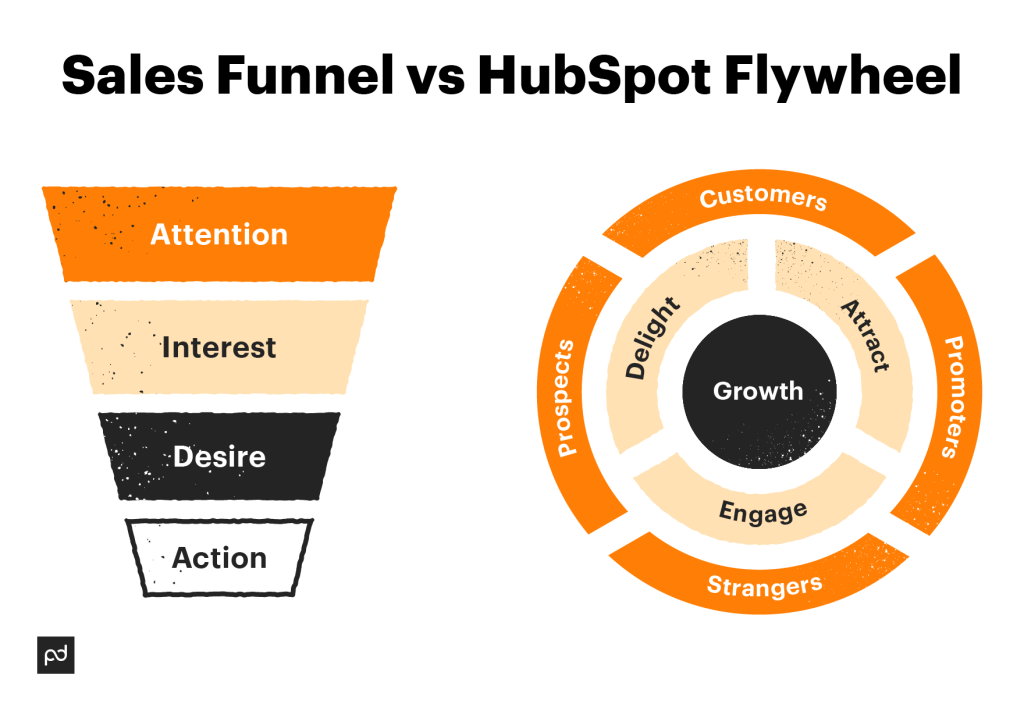
Why would you need a sales funnel?
It’s possible that your current marketing efforts are working well for you and your team, and you only need a landing page to convert prospective customers.
Even in situations like these, we would still suggest implementing a process for the sales pipeline — be it a sales funnel, a flywheel, or your marketing funnel.
Here are a few reasons why many businesses are opting to use a sales funnel to convert prospective customers into paying customers.
1. Lead nurturing takes time
Rome wasn’t built in a day, and neither are your customers’ purchasing decisions (except when it’s an impulse buy).
A typical purchasing decision requires product discovery, information, consideration, and then purchase.
In your sales cycle, you will likely interact with your prospective customer for multiple months (through approximately twelve touchpoints) for them to convert.
That being said, time is relative based on how complex the problem is that your product will solve.
For example, if you’re selling a meal service subscription, you might acquire customers in a few days, or even minutes — one semi-casual AIDA experience for them could result in a repeat customer for you.
On the flip side, if your product is a company-wide collaboration software, a prospect might take months to convert.
A lot of it also depends on the person, and your sales cycle will shift a little from prospect to prospect.
However, even with all this considered, getting your new lead from the awareness stage and the interest stage to the purchasing decision will take time, and a sales funnel can help you navigate through these stages and touchpoints.
2. Creates customer experience
A wise man (Bill Gates) once said, “In business, the idea of measuring what you are doing, picking the measurements that count like customer satisfaction and performance… you thrive on that.”
The only way you can create a delightful customer experience is by engaging with them.
So, in order to improve your customer experience, excel at customer relationships.
A sales funnel is one of the best ways to achieve this because you’re interacting with your customers every step of the way — every piece of content that you create, or every lead magnet that you write, it’s all done with the strategic intention of interacting with the customer.
To achieve better results with the sales funnel, some businesses also use marketing automation, which engages and delights customers.
All of these are ways in which you can create a positive customer experience.
Stages of a sales funnel
As discussed before, there are many different sales funnels in the market — some have four stages, some have five, and some six.
And surprise of all surprises, some may even have seven stages. Some are not even funnels; they are flywheels — you get the gist.
In this article, though, we’re taking the simple-is-best approach and just discussing the good ole four-stage sales funnel.
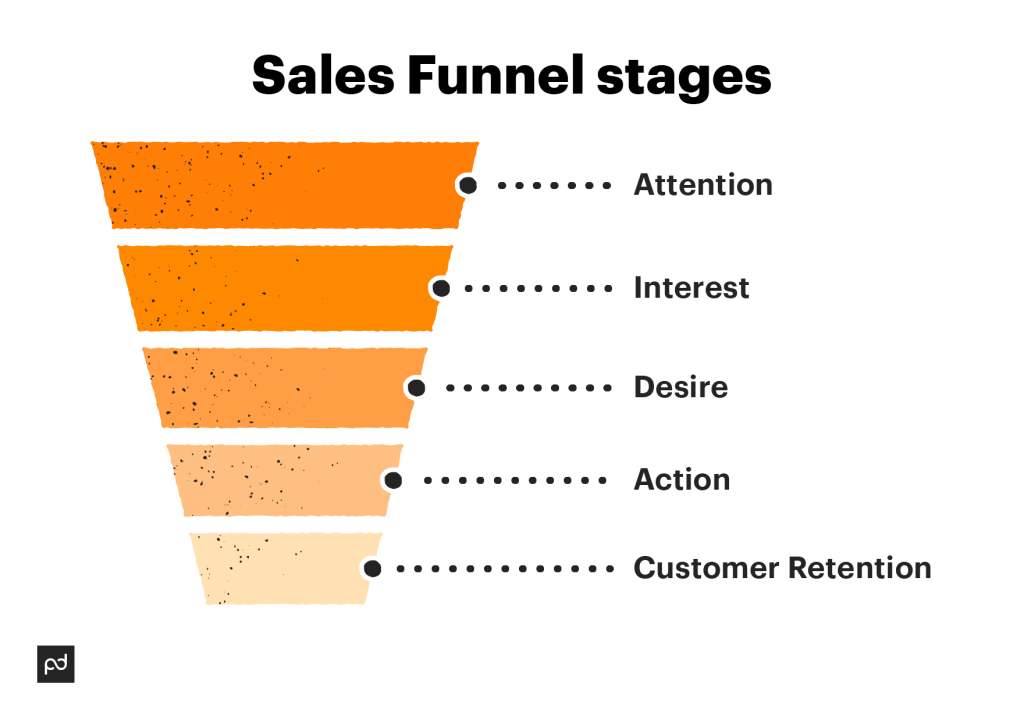
Stage 1: Attention stage
The attention stage is at the very top of the funnel, and in that regard, it’s quite wide and welcoming. This stage will have both kinds of leads, the high- and low-qualifying ones.
And, as the name suggests, your sole job is to make your prospective customer aware of your product/service, and why your brand stands out.
At this stage, your aim couldn’t be more basic: encourage your leads to move on to the next stage, which means getting them interested.
Your prospects may or may not know that they want to buy a product or service that your company offers, but your value proposition — by gaining their attention — should be strong enough that they’ll believe this is a product/service that they need.
What to do at this stage: Optimize all your social media channels, curate different types of content (blogs, infographics, videos, etc.), and use digital marketing as well as offline marketing to drum up interest for your brand and what you’re selling.
Stage 2: Interest stage
Once a lead knows enough about what your company offers, and they’re now curious about your product/services — they enter this new territory, what we call the interest stage.
The interest stage is identified at the middle of the funnel (which also includes consideration and evaluation, if your funnel was expanded).
This is where you educate potential customers about all the ways in which you differ from your competitors, the kind of value you offer, and the benefits they’d reap by buying your product/service.
Targeting customer pain points is the ultimate priority of this stage, and you can do this by reaching out to your existing customers and understanding what kind of value they want from a product.
What to do at this stage: Identify the pain points of your customers and engage with them through blogs, webinars, educational videos, case studies, email campaigns, lead magnets, and retargeting campaigns. A/B test your landing pages for website visitors and study analytics for marketing campaigns.
Stage 3: Desire stage
The desire and action stages are called the “bottom of the funnel” stages.
If your lead passes all the other checkpoints with flying colors and has landed here, this means they’re a high-quality lead who just needs to purchase the product/service at the next stage.
What you need to do here is tell your customers that you understand their problems — and publishing niche-specific content is a sure way to send that message.
Aside from that, give them all the reasons to want to buy your product (this includes social proof and discounts).
Zapier is a pro at BOFU (bottom of the funnel) content, so check out their BOFU content marketing strategy to gather some inspiration.
What to do at this stage: Customer testimonials, discount codes, user reviews, how-to videos and content, training videos, etc., will all help at this stage. Basically, employ any opportunity that allows you to brag about your product.
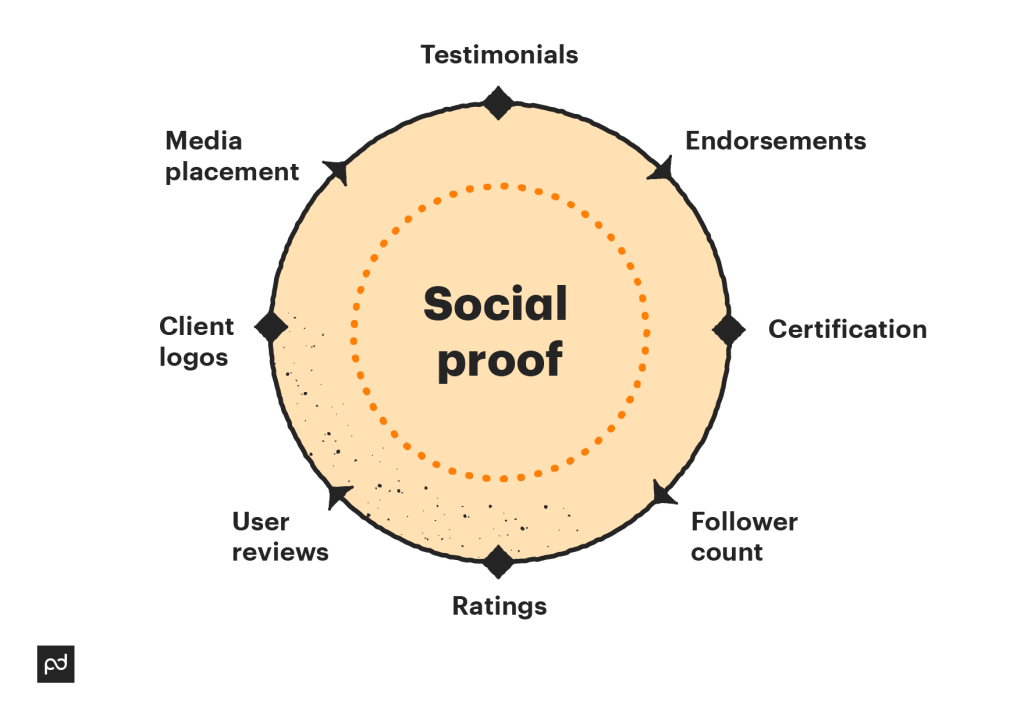
Stage 4: Action stage
The action stage (also known as the decision stage) is the final stop in your funnel — this is the place where your customer either converts or doesn’t (there’s no way around it).
Aside from assisting your customer with their buying decision, there’s not much else you can do at this point.
Pro-tip: Make sure to follow up within the first 24 hours with your prospective customer, as it increases your chance of being responded to by 25%.
Here’s a resource that will help you craft a stellar follow-up email: A completed guide to sales follow-up.
What to do at this stage: Create useful content featuring insider tips and/or user manuals. Send over bundled packages, follow-up offers, and time-sensitive promotional offers.
Bonus stage: Customer retention
The four-stage sales funnel is a pretty solid structure for gaining new customers, but it doesn’t factor in customer retention. So this “bonus stage” is all about retaining customers once you acquire them.
By using this to your advantage, you won’t need to go through all four AIDA steps to complete a sale. You can simply engage with your current clientele so that they become repeat purchasers of your brand and its products/services.
In other words, another pro-tip here: Customer retention over customer acquisition, any day of the week, please and thank you.
Engagement at this stage will also build brand loyalty, and increase word-of-mouth referrals, so all in all, it is a big win-win.
What you simply need to do here is understand if your customer is satisfied with your product or not. If they are, you need to re-engage with them.
If not, then feedback never hurt anyone (and may very well help future marketing decisions).
What to do at this stage: Send out surveys, introduce loyalty programs, offer rewards for referrals, create gold-standard after-sales service, etc.
How to create a successful sales funnel
Now that you know all the steps of creating a stage-by-stage sales funnel, you need to address a few things to make sure your funnel is successful.
1. Identify buyer personas
Understanding the target audience is the no.1 priority of any marketer.
However, since the funnel is so wide, and takes into account all kinds of leads, you need to list the attributes that make up your ideal customer.
Just so that you know you’re addressing all their pain points the right way, and you’re speaking to them in language they clearly understand.
For example, if I’m selling something as common as a pair of scissors, I’ll have multiple kinds of leads to target, and they will all behave and interact differently.
Hence, identifying the ideal customer from a sea of customers really helps.
Data is a sure way to understand buyer personas in-depth; however, there are other ways in which you can understand your audience too.
This resource will help you in identifying buyer personas: 5 foolproof ways to understand your target audience.
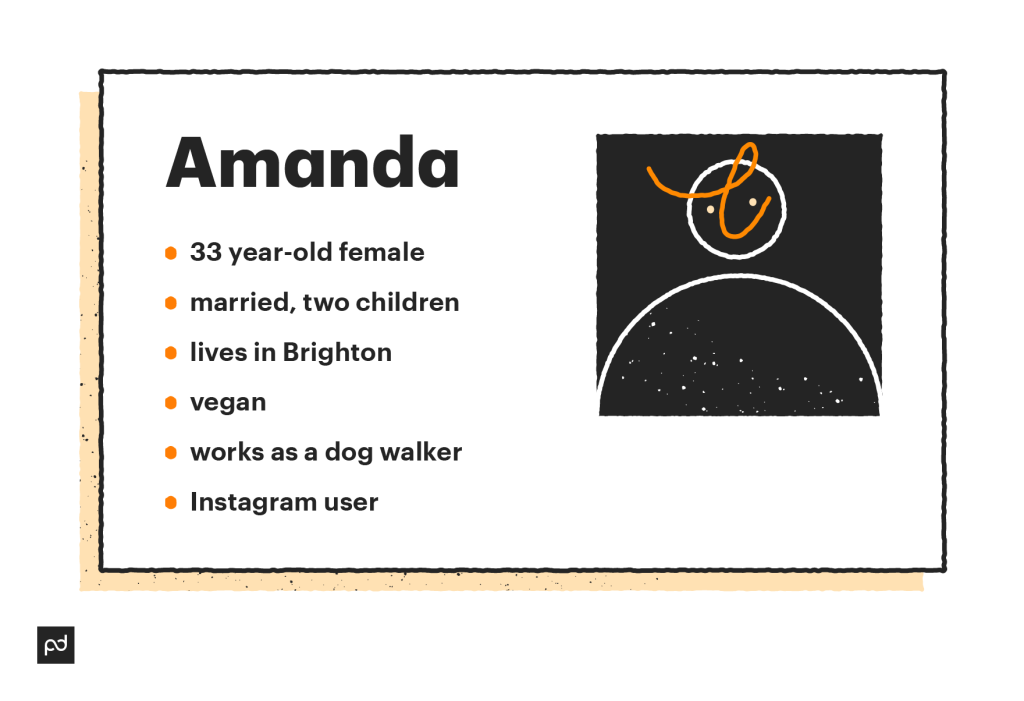
2. Understand intent
We spoke about how you should create content at every stage of your funnel. If you’re wondering, “what kind of content do I create at which stage?” — that’s a fair question.
The answer to this is intent: you know what type of content to create based on the intent behind what your leads want to see.
Customers who are at the top of the funnel (TOFU) typically have different content requirements from those who are in the middle of the funnel (MOFU) or the bottom of the funnel (BOFU).
This guide will help you understand what kind of content to use where: The difference between TOFU, MOFU, and BOFU content offers.
3. Use marketing automation
If you want to scale your business, automation is the way to go. Instead of simply telling you why it’s important, we’ll share a few statistics that will help validate our points:
- 77% of users who used marketing automation saw an increase in conversion rates.
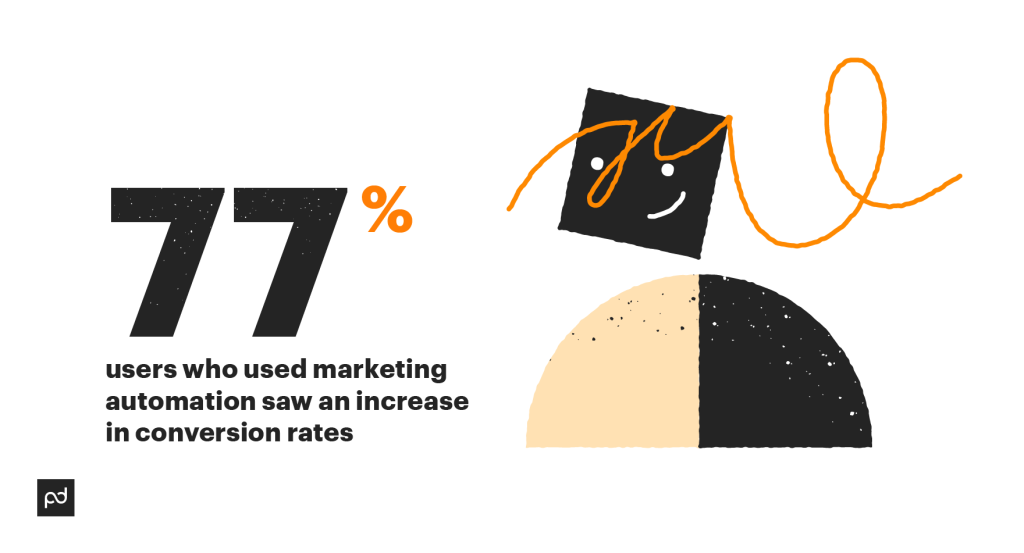
- 66% of marketers saw an increase in their department’s efficiency after using marketing automation.
- 48% of marketing professionals believe that it is one of the most effective ways of personalizing an experience
- 75% of marketers agreed that they use marketing automation software tools.
Our point is that it’ll help you get qualifying leads, improve conversation rates, will help with nurturing leads, and save time.
A pretty solid investment, if you ask us!
TL;DR
The sales funnel stages might be tricky to understand at first, but the more you use the funnel, the better you’ll get a firm grasp of how it works.
Each company has its own set of workflows to acquire and retain customers, but the sales funnel is one such strategy that has worked for hundreds, if not thousands, of marketers around the globe.
We think the best way to perfect this strategy (aside from understanding buyer personas and intent) is through marketing automation.
Just like the sales funnel itself, PandaDoc is one such tool that has been tried and tested by thousands of marketers for automation. You can see just how much our customers love us by reviewing our testimonials.
Why the love, you ask? We improved their close rates by 36%, and in only half the time.
Read on to better understand how PandaDoc can help your sales team as well.
Originally published Jan 14, 2020, updated Jul 6, 2022
Disclaimer
Parties other than PandaDoc may provide products, services, recommendations, or views on PandaDoc’s site (“Third Party Materials”). PandaDoc is not responsible for examining or evaluating such Third Party Materials, and does not provide any warranties relating to the Third Party Materials. Links to such Third Party Materials are for your convenience and does not constitute an endorsement of such Third Party Materials.